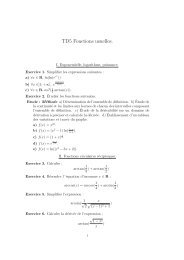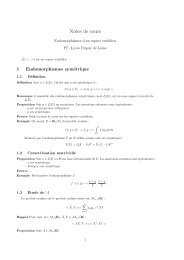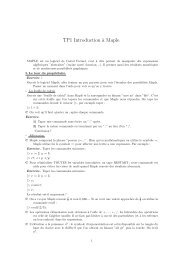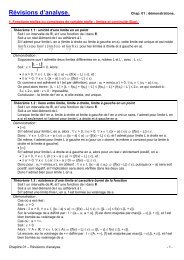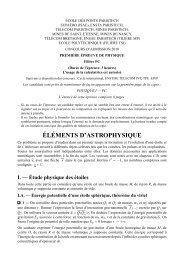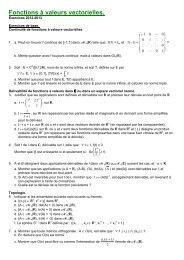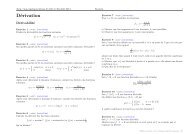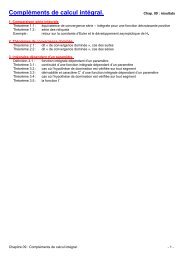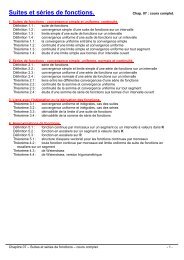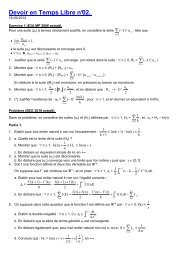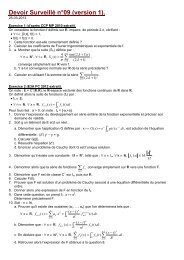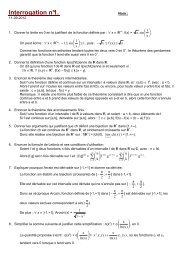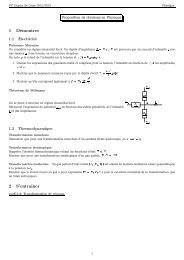[http://mp.cpgedupuydelome.fr] édité le 4 juin 2013 Enoncés 1 ...
[http://mp.cpgedupuydelome.fr] édité le 4 juin 2013 Enoncés 1 ...
[http://mp.cpgedupuydelome.fr] édité le 4 juin 2013 Enoncés 1 ...
You also want an ePaper? Increase the reach of your titles
YUMPU automatically turns print PDFs into web optimized ePapers that Google loves.
[<strong>http</strong>://<strong>mp</strong>.<strong>cpgedupuydelome</strong>.<strong>fr</strong>] <strong>édité</strong> <strong>le</strong> 26 juil<strong>le</strong>t <strong>2013</strong> <strong>Enoncés</strong> 25<br />
Exercice 139 [ 03187 ] [correction]<br />
I) Soit E un espace euclidien et A un sous-espace vectoriel de E.<br />
a) Démontrez que<br />
E = A ⊕ A ⊥<br />
(indice : on admettra que toute famil<strong>le</strong> orthonorma<strong>le</strong> de E peut être co<strong>mp</strong>létée en<br />
une base orthonorma<strong>le</strong> de E.)<br />
b) Démontrez que<br />
A ⊥ ⊥ = A<br />
II) Soit f une fonction réel<strong>le</strong> de classe C1 positive et décroissante sur I = [a, b].<br />
Soit g une fonction continue sur I. On définit G : I → R par la relation<br />
G(x) =<br />
a) Montrer qu’il existe m, M ∈ R tels que<br />
b) Montrer que<br />
b<br />
a<br />
x<br />
a<br />
g(t) dt<br />
G ([a, b]) = [m, M]<br />
f(t)g(t) dt = f(b)G(b) −<br />
c) En déduire qu’il existe c ∈ [a, b] tel que<br />
b<br />
d) Application : déterminer<br />
a<br />
f(t)g(t) dt = f(a)<br />
lim<br />
x→+∞<br />
1<br />
x2 1<br />
1/x<br />
b<br />
a<br />
c<br />
a<br />
sin t<br />
dt<br />
t2 f ′ (t)G(t) dt<br />
g(t) dt<br />
Exercice 140 [ 03191 ] [correction]<br />
I) Soit h une fonction continue et positive de [a, b] dans R.<br />
a) Démontrez que :<br />
b<br />
a<br />
h(x) dx = 0 ⇒ h = 0<br />
b) Soit E <strong>le</strong> R-espace vectoriel des fonctions continue de [a, b] dans R. On pose<br />
pour tout f et tout g de E<br />
(f | g) =<br />
b<br />
a<br />
f(x)g(x) dx<br />
Démontrez que l’on définit ainsi un produit scalaire sur E.<br />
c) Majorez<br />
1 √ −x<br />
xe dx<br />
en utilisant l’inégalité de Cauchy-Schwarz.<br />
II) Soient α ∈ R\Z et f : R → R la fonction 2π périodique définie par<br />
0<br />
f(t) = cos(αt) sur ]−π, π]<br />
a) Montrer que f admet une série de Fourier convergente sur R.<br />
Quel type de convergence est-ce ?<br />
b) Expliciter <strong>le</strong>s coefficients de Fourier de f.<br />
c) Pour tout x /∈ πZ, montrer l’égalité<br />
cotanx = 1<br />
x +<br />
Exercice 141 [ 03192 ] [correction]<br />
∞<br />
n=1<br />
2x<br />
x 2 − (nπ) 2<br />
I) Ces fonctions sont-el<strong>le</strong>s intégrab<strong>le</strong>s ?<br />
sin x2<br />
a) x ↦→ ln x x2 sur ]0, +∞[<br />
b) x ↦→ x<br />
x−2e−x sur ]2, +∞[<br />
II) On considère l’espace vectoriel Rn muni de son produit scalaire usuel noté<br />
〈. | .〉. Soit f un endomorphisme symétrique de Rn dont toutes <strong>le</strong>s va<strong>le</strong>urs propres<br />
sont strictement positives.<br />
a) Montrer que<br />
∀x ∈ R n \ {0} , 〈f(x) | x〉 > 0<br />
b) Soit u un vecteur de R n et g : R n → R l’application définie par<br />
g(x) = 1<br />
〈f(x) | x〉 − 〈u | x〉<br />
2<br />
Montrer que g admet des dérivées partiel<strong>le</strong>s selon tout vecteur de R n et <strong>le</strong>s<br />
expliciter.<br />
c) Montrer que g admet un unique point critique noté z.<br />
d) Montrer que g admet un minimum global en z.<br />
Exercice 142 [ 03193 ] [correction]<br />
I) Soient F(R, R) l’espace vectoriel des applications de R dans R, E <strong>le</strong> sous-espace<br />
vectoriel engendré par <strong>le</strong>s cinq applications :<br />
f1 : x ↦→ 1/ √ 2, f2 : x ↦→ cos x, f3 : x ↦→ sin x, f4 : x ↦→ cos(2x) et f5 : x ↦→ sin(2x)<br />
Diffusion autorisée à titre entièrement gratuit uniquement - dD


![[http://mp.cpgedupuydelome.fr] édité le 4 juin 2013 Enoncés 1 ...](https://img.yumpu.com/19249082/25/500x640/http-mpcpgedupuydelomefr-edite-le-4-juin-2013-enonces-1-.jpg)
